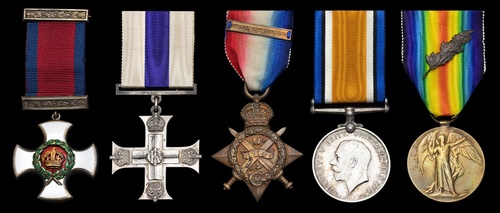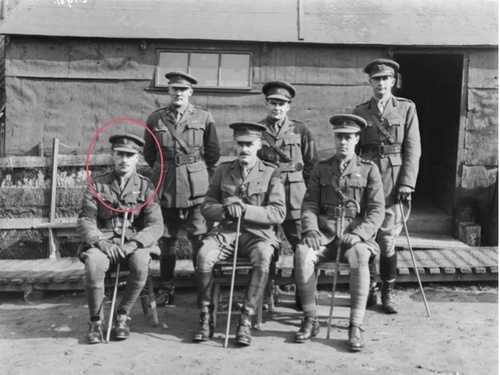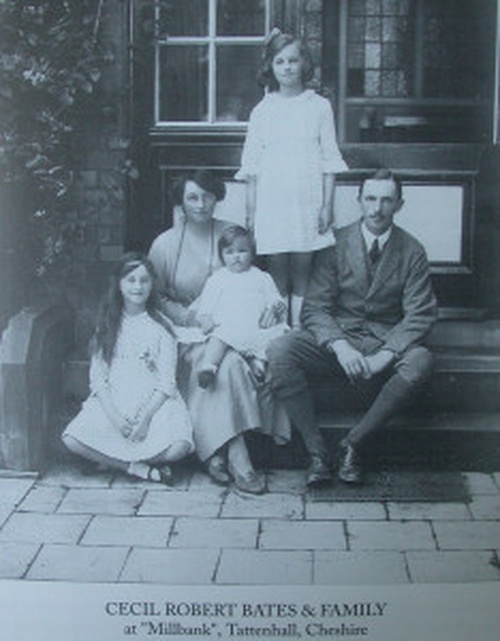Auction: 25001 - Orders, Decorations and Medals
Lot: 335
(x) The Great War D.S.O., M.C. group of five awarded to Lieutenant-Colonel C. R. Bates, Royal Field Artillery, who served as Brigade Major with the 4th Australian Division on the Western Front, suffered a gunshot wound to his right arm and was thrice 'mentioned'
Distinguished Service Order, G.V.R., silver-gilt and enamel; Military Cross, G.V.R. (Major C. R. Bates, R.F.A. France, 1915.); 1914 Star, clasp (Capt: C. R. Bates. R.F.A.); British War and Victory Medals with M.I.D. oak leaves (Major C. R. Bates), slight chipping to reverse of D.S.O. enamel, Victory Medal well-polished, otherwise very fine overall, housed in contemporary wood display frame (5)
D.S.O. London Gazette 1 January 1918, the original recommendation states:
'Marked devotion to duty and conspicuous ability as Brigade-Major 4th Australian Divisional Artillery during period in France from July 7th 1916 to July 30th 1917, especially operations before the Hindenburg Line at Bullecourt during April and May 1917, and operations before Messires during May and June 1917.
Signed E.H. Sinclair Maclagh, Brigadier-General, commanding 4th Australian Division.'
M.C. London Gazette 14 January 1916.
M.I.D. London Gazette 31 December 1915; 15 May 1917; 7 December 1917. One original recommendation states:
'Marked devotion to duty and conspicuous ability as Brigade-Major, 4th Australian Divisional Artillery, during period in France from July 7th 1916 to February 25th 1917, especially during operations opposite Fromelles in conjunction with 5th Australian Division on July 19th 1916; during operations in Ypres Sector from August 27th 1916 to November 10th 1916, and during operations on the Somme, from November 25th 1916 to February 25th 1917.
Signed William Holmes, Major-General, commanding the 4th Australian Division.'
Cecil Robert Bates was born at Wavertree, Lancashire on 3 February 1882. He was the third of seven sons of Sir Edward Percy Bates, 2nd Baronet, and his wife Constance Elizabeth Graves of the wealthy Bates shipping family. He was additionally the grandson of conservative Member of Parliament Samuel Robert Graves. It is worth also noting the illustrious life of Bates’ elder brother Sir Percy Elly Bates, 4th Baronet. An honorary Captain of the Royal Naval Reserve, Percy Bates was throughout his busy life the longtime Chairman of the Cunard-White Star Line, High Sheriff and Justice of the Peace for Cheshire, and was made a G.B.E. in 1920 for his services as Director of Commercial Services in the Ministry of Shipping.
The young Bates was educated at Winchester and the Royal Military Academy at Woolwich. His was an active military family, with his brother Frederic later becoming a Major in the Royal Air Force and winning an A.F.C., and his other brother Denis an Army Colonel who was mentioned in despatches and also received an M.C.
Bates was commissioned into the Royal Field Artillery on 6 January 1900 as a Second Lieutenant. He was advanced Lieutenant on 3 April 1901 and a few years later in 1904 was transferred to the Royal Horse Artillery. In August of that year Bates was sent to India, where he served until returning home in December 1907. He found himself promoted Captain on 16 June 1908 and continued to serve with the Royal Horse Artillery until 1911. Bates retired to the Reserve of Officers on 27 August 1913.
He was not to enjoy his retirement for long, however, and was recalled to service on the outbreak of World War I. Bates disembarked at the Western Front on 14 September 1914 and was to serve overseas for much of the war. He suffered a gunshot wound to his forearm and was subsequently sent home and admitted to Queen Alexandra's Military Hospital at Millbank on 13 April 1916. It must not have been terribly serious as he was released just a few days later.
He was appointed Brigade-Major of the Australian Imperial Force, 4th Division, on 8 July 1916. Bates found himself again at hospital in 1918, when he was admitted to 2nd General Hospital from the Royal Field Artillery Training School on 10 December complaining of ‘stiff joints’.
Prior to the close of the war, on 27 June 1918 Bates was married to Hylda Madeleine Heath, daughter of Sir James Heath, 1st Baronet. Hylda was a widow at the time, having been married to Captain George Millais James of The Buffs (East Kent) Regiment, who was killed in action on the Western Front in 1914. Their two daughters, Eileen and Daphne, were subsequently adopted by Bates. Together the newly married couple also had two children; Audrey Cecil Bates and Sir Geoffrey Voltelin Bates, 5th Baronet, who would go on to receive a M.C. of his own while serving as Second Lieutenant of the 8th King’s Royal Irish Rifles in the Western Desert in September 1942.
Soon after the end of war Bates relinquished his command on account of ill-health on 4 January 1919, retaining the rank of Major (London Gazette 6 May 1919, refers). He then returned home to his family residing at Oxendon Hall in Great Oxendon, Northamptonshire, and became the managing director of the West African Trading Company.
Bates later died at age 53 on 5 March 1935, suffering heart failure while salmon fishing in the River Dee in Banchory, Scotland. The Northampton Mercury reported that only moments before his death he had caught a 17 lb salmon. Bates left behind an estate worth £133,110 - the equivalent of over £12 million today. His widow Hylda later died in 1960; sold together with a binder of copied research, including copied photographs.
Subject to 5% tax on Hammer Price in addition to 20% VAT on Buyer’s Premium.
Estimate
£2,000 to £3,000
Starting price
£1800









